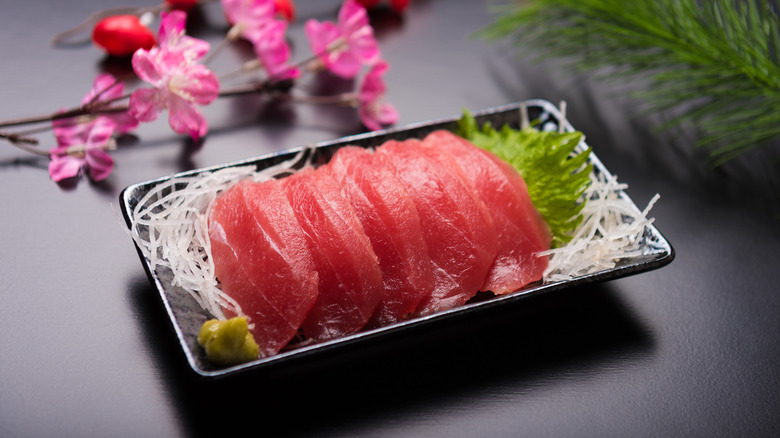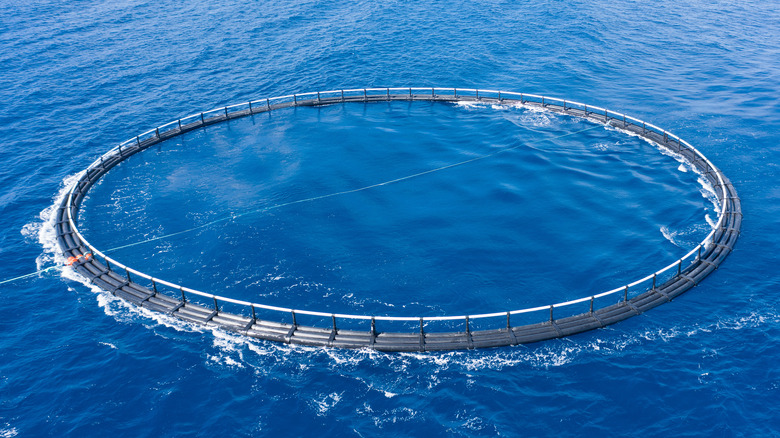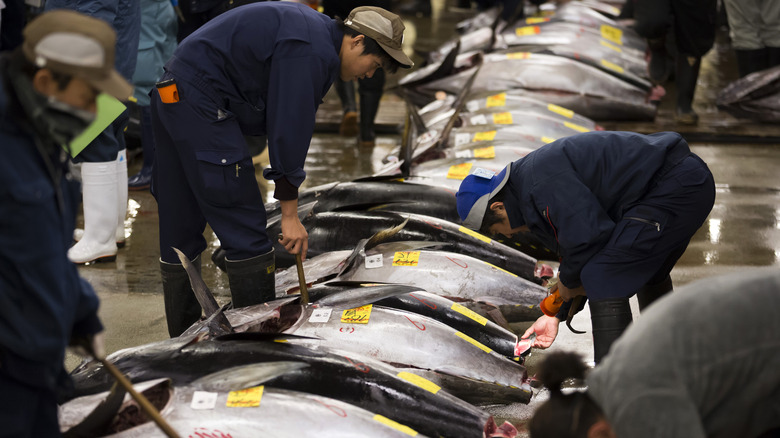The Unexpected Place Japan Sources Some Of Its Sashimi Tuna From
Bluefin tuna, widely considered one of the most delicious and desirable fish on the planet, comprises three distinct varieties of fish: Atlantic bluefin, Pacific bluefin, and southern bluefin, according to Fishing Booker. These bluefin tuna are voracious predators, consuming cephalopods, small fish, and crustaceans in their youth before they graduate to herring, mackerel, sardines, anchovies, and bluefish. Bluefin tuna can live up to 40 years, though that's increasingly unlikely to happen, as they're one of the world's most valuable fish, a prize that fetches astonishing prices. How valuable is bluefin tuna? In 2019, according to BBC, Japanese "Tuna King," Kiyoshi Kimura paid $3.1 million for a single 612-pound bluefin tuna, shattering the previous record price he had set in 2013.
Kiyoshi Kimura isn't the only person in Japan clamoring for bluefin; Japan is the single largest market for bluefin tuna, responsible for 80% of the world's consumption, NPR explains, and that poses a problem. Pew Trusts, in 2020, pointed out, "All three bluefin species are depleted, the Pacific and southern species severely so." Fishing Booker adds, "Since people first started fishing for Pacific Bluefin Tuna in the 50s, the population has declined by a frightening 96.4%." When you add Japan's demand for sashimi tuna to the growing demand worldwide, there's one obvious question: Where are all the bluefin tuna going to come from?
About 30% of bluefin tuna in Japan comes from one country
The Global Seafood Alliance explains that most tuna fishing in Mexico is focused on yellowfin and skipjack tuna, nearly all of which ends up as canned tuna. When the main tuna port was moved from Ensenada to ports further south, it took both jobs and revenue from the northern port, creating an opportunity: tuna ranching, also known as tuna farming.
In the Mexican port of Ensenada, the base for Mexico's tuna ranching, boats using purse seines live-capture young Pacific bluefin tuna as they migrate between the western Pacific and the eastern Pacific waters. CNBC explains these live fish are transferred, slowly and at great expense, to pens in the ocean waters near Ensenada, where they're fed on local sardines until they've grown to a commercially viable size, per Global Seafood Alliance. Most of these Pacific bluefins are destined for Japan, and since the late 1990s, roughly 30% of Japan's sashimi-grade bluefin Tuna has been sourced from these Mexican tuna ranches. The source of thousands of local jobs for the Mexican port of Ensenada, Baja California's annual bluefin production has been about 4,000 to 5,000 metric tons, worth roughly $80-$90 million annually.
How sustainable is tuna ranching in Mexico?
The answer about whether tuna ranching is sustainable depends on who you ask. Global Seafood Alliance emphasizes the measures taken to reduce environmental impacts on local fish populations and water quality. One of the Mexican farms, Baja Aqua Farms, declares its commitment to sustainability and "ensuring the protection of the species for future generations."
The International Union for the Conservation of Nature (IUCN), however, listed the Pacific bluefin as "vulnerable" in 2014, according to CNBC, and while IUCN's 2021 update moved the designation to a lower "near threatened" level, it also noted that the current biomass of the fish is less than 5% of original levels.
Tuna ranching endangers bluefin tuna populations because it relies on the capture of juvenile fish too young to reproduce, according to CNBC. And while some champions of the practice point to rebounding numbers of Pacific bluefin, Seafood Watch still, in 2022, maintains all three bluefins, Pacific, Atlantic, and southern, on its Red List of seafood that should be avoided. Seafood Watch cites the threat to wild stocks from which farmed fish are culled, along with the environmental impacts of farming fish that require vast amounts of wild fish used for food, as well as likely "nitrogen-based effluent" produced by tuna ranching. While some kinds of tuna may be sustainable, Fishing Booker argues that protecting bluefin tuna populations will take both international cooperation and time for recovery.


